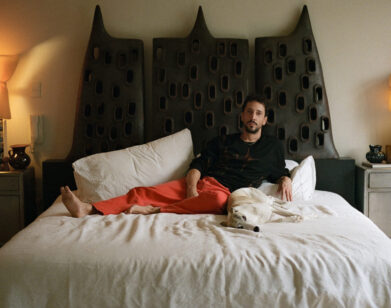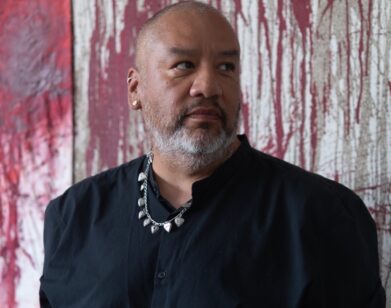Carol Crawford’s Time Machine
In the catalogue for Carol Crawford’s new exhibit, “Time Frames,” scholar Arnold Berleant says the following about the artist’s work: “Unlike windows that painters were once advised to emulate with their own frames, these constructions are more like doors through which one can pass to enter the landscapes they contain.”
Based in New York where she also teaches at the Pratt Institute and serves on the boards of several galleries and art institutes, Crawford has long sought to fuse her many talents in photography, drawing, painting, sculpture, film and architectural design with her love of history and storytelling. In “Time Frames,” which opened yesterday at Atlantic Gallery in Chelsea, Crawford takes us through strangely familiar settings and spaces. Each work presents a layered history of memories: a color photograph of a present-day room is overlaid with transparent figures of past inhabitants—Crawford’s family—from old photographs; a house-lined street reincarnates its Victorian life through black and white images of children playing and vintage cars driving by, set against brightly colored trees and homes with modern touches. Through a combination of photography—both old and new— drawing, and painting, Crawford’s work uncovers how spaces are filled not only by what one can see with the naked eye, but also by whisperings ghosts.
NOOR BRARA: Tell me a little bit about the pieces that you’ll be showing for Time Frames; how did they come to be and how did you choose the locations in which these scenes take place? I noticed a lot of them were recognizable scenes of American life and places that people can relate to—the insides of homes, suburban streets, and the Hudson River promenade, for example.
CAROL CRAWFORD: I think I’ve always wanted to do it. This body of work was all made in 2014, so there’s definitely a misty thread throughout it in what I was trying to do. The spaces I choose are usually unoccupied, or occupied peripherally, but I’d always imagined them to be great settings for past scenes to be reenacted or recreated. In one case (Empty Room), I was inspired by a family photograph with my maternal grandfather, whom I never knew. My mother revered him, though, and she always supported the artist in me because he was one, too. So, for that, I imagined the figures in my family photograph into a living room space, and had images of other families, both past and present, hung on the walls to show that every place always has its history. And everything that happened is all connected in a way. In that respect, many of the places I chose were somewhat personal; others were just places where I felt a lot had happened.
BRARA: How did you come up with the idea of having all of these past memories filtering into present spaces?
CRAWFORD: I think maybe because I was an only child for a long time in a very big family, and I used my imagination a lot when I would listen to grown ups telling stories. I spent a lot of time on the floor, at the top of the stairs, listening to everything being said below in the evenings—it was so much fun to hear about things that had happened in the rooms of the house. Just from listening to stories when I was a child, I’d always imagined spaces as intensely populated, even though there may not be anyone actually in a room when you walk into it. Their stories are still there, even simply represented by the objects that are left behind—people make messes and their traces are everywhere. In terms of the art process, Photoshop really helped to convey that in using the transparencies to create layers of what had happened in each space over time. I would float these old photos in over the drawings and, in that process, the past memories would meet present life in a kind of collective history.
BRARA: In many of the works, you have colored markings highlighting certain features of each photograph. They almost look like drafting lines from an architectural blueprint. Can you tell me a little bit about why you did that?
CRAWFORD: Yeah, that’s exactly what they are—draftings and line drawings over the photographs to give them dimension. Because there are so many layers in my work, it’s difficult to tell which ones are at the forefront. So it was really about positioning, and about bringing each piece to life—making them 3-D without allowing the lines to completely disturb the vision. At the same time, they’re there so that what you’re seeing is constantly changing. When you blink, it annoys the eye not to be able to focus on one clear image. It prompts people to keep looking, and to consider every layer of the work, as the lines extend the motion of the figures that are already there. Either they highlight the plants and flowers of a garden space or they elongate a line in the forefront to call attention to something happening behind it. They help to pick out details of a figure and suggest spatial differences.
BRARA: I love the use of it in the couple shown in Staircase. The clearest image in this piece is their starting out together, perhaps newly married in a new home. And then you see, in the second layer, a more transparent version of them at the top of the stairs, suggesting they’ve shared a journey together and have separated. You outline the woman’s figure in this layer as completely separate from her husband’s, which really calls attention to the change in their relationship.
CRAWFORD: Somebody commented on that, actually. It sometimes takes me a while to understand my work, but after a while I realized that it’s true, the couple at the top of the stairs is completely separate than when they began their lives together. It doesn’t mean they’re divorced; it’s just sort of an implication of what happens in many relationships. You grow up, you have kids, and you’re separate. It wasn’t a personal history thing for me. It’s just life sometimes, and part of this thread of change that runs through all the work.
BRARA: In that sense, it seems like many of the human relationships portrayed in your works are highly emotive and go through transitions through each layer of time. Was that something that was a focal point when you were making them? Was it important for you to show that the people in them are just as dynamic as the spaces they’re in?
CRAWFORD: Yes, I think so. Definitely. If only I could figure out how to show that dynamism and make the figures actually move! [laughs] But yes, motion is really important for me to illustrate—time moves, and in every layer there’s a kind of change happening. There are one or two in which there aren’t any people in it necessarily, but there is a human perspective that is represented by the changing of the image through the layers and how we view the same scene as we change. Many of the photographed figures are my family, but they’re not really supposed to be considered that way. They stand for people in general, people that were in these places at one time or another before cameras were around to capture them there. I love the history element behind it. I study history in the same way people read novels. You want to savor the best parts of every story, and I think that’s what each work does through the human relationships—I string them all together through a common place. It all fits in.
BRARA: You can definitely tell that these places are loaded with strains of interconnectivity between each event that had taken place there. You really convey that the past informs our present.
CRAWFORD: I’m glad that people can see that, because my favorite part of all of this was discovering the stories behind these people. I loved learning about my genealogy and infusing the spaces with what I learned—picking up threads here and there about my ancestry, and exploring the old sites where family members had lived. The more I find out, the more I realize how complicated it all is—how anyone’s history, whether it’s personal or something larger, is. But it’s a constant search to connect all the dots, and this is kind of a presentation of what I’ve been able to put together.
“TIME FRAMES” IS CURRENTLY ON SHOW AT ATLANTIC GALLERY IN NEW YORK.







